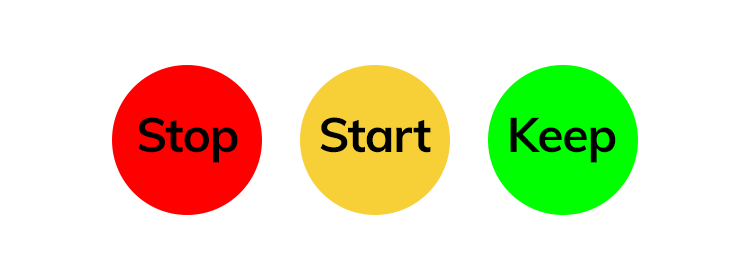
In 30 seconds
It’s the end of the financial year in Australia, and it’s a good time to recognise our successes and reflect on what we’ve learned on the financial year 22/23.
At Barrett we use the “Stop, Start and Keep doing” tool:
- Stop – What do I/we want to Stop Doing? Identify practices, behaviours, or processes that don’t work for you/your team. This way you can phase it out.
- Start – What do I/we want to Start Doing? Identify new practices, behaviours, thoughts, or processes that could bring positive change.
- Keep doing: What do I/we want to Keep Doing? Acknowledge what works and successes you/your team had in the last 12 months. This helps maintain motivation and ensures that valuable practices are not overlooked.
In 2 minutes
As many businesses pull out all stops to finalise the end of the Australian financial year 22-23, it might pay to take time out to review and reflect on the lessons learned, your successes and failures, and what you’d like to do in the future.
At Barrett, we use the “Stop, Start & Keep doing” exercise as a very effective reflection and learning technique. It can be applied across many areas, including project management, team building, and personal development. We always use it at the end of training sessions with our participants -no matter what the subject- to reflect on past practices and identify areas for improvement.
The exercise is easy to apply and involves three key components:
- Stop – What do I/we want to Stop Doing? Participants are asked to identify practices, behaviours, thoughts or processes that are hindering progress or no longer effective. By identifying these elements, the goal is to eliminate or phase out practices that are no longer beneficial to self, the team, business, or project.
- Start – What do I/we want to Start Doing? Participants are encouraged to identify new practices, behaviours, thoughts, or processes that could bring positive change or enhance productivity, performance, wellbeing, and mastery. This could involve implementing new tools, technologies, skills, or techniques, adopting improved communication strategies, or introducing innovative approaches. The focus is on identifying areas where change is needed and proposing new ideas and ways to address them.
- Keep doing: What do I/we want to Keep Doing? This component acknowledges and reinforces successful practices, behaviours, thoughts, or processes that are contributing to positive outcomes. Participants identify elements that have been effective and should be continued in the future. This recognition helps maintain motivation and ensures that valuable practices are not overlooked or discarded.
Stop-Start-Keep encourages open and constructive feedback, allowing participants to share their perspectives, insights, and suggestions for improvement. By engaging in this exercise, teams and individuals can foster continuous improvement and drive positive change in their work and personal lives.
So, what do you and your team want to Stop, Start and Keep Doing for FY 23-24?
Remember, everybody lives by selling something.
Testimonial
“The team is winning larger, profitable sales in highly competitive, commoditised market places and winning the ‘share of mind battle’ with our clients & prospects.”
Related topics
From EQ to RQ: The Evolution of Emotional Intelligence
Soft Skills, Selling, and Micro-Credentials
A year ago
Decarbonised Economic Models and Systems
Three years ago
Lost Sales Revenue? – Start Fixing it Now


New Article Email Notification